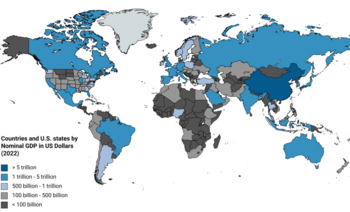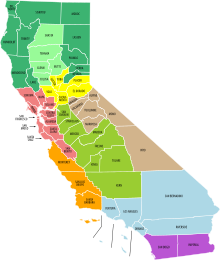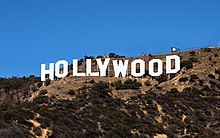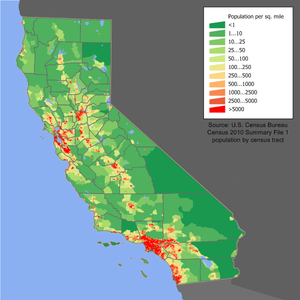Main article: Education in California
Public secondary education consists of high schools
that teach elective courses in trades, languages, and liberal arts with
tracks for gifted, college-bound and industrial arts students.
California's public educational system is supported by a unique constitutional amendment that requires a minimum annual funding level for grades K–12 and community colleges that grows with the economy and student enrollment figures.[144]California had over 6.2 million school students in the 2005–06 school year. Funding and staffing levels in California schools lag behind other states. In expenditure per pupil, California ranked 29th (of the 50 states and the District of Columbia) in 2005–06. In teaching staff expenditure per pupil, California ranked 49th of 51. In overall teacher-pupil ratio, California was also 49th, with 21 students per teacher. Only Arizona and Utah were lower.[145]
A 2007 study concluded that California's public school system was "broken" in that it suffered from over-regulation.[146]
California's public postsecondary education offers three separate systems:
- The research university system in the state is the University of California (UC), a public university system. As of fall 2011, the University of California had a combined student body of 234,464 students.[147] There are ten general UC campuses, and a number of specialized campuses in the UC system. The system was originally intended to accept the top one-eighth of California high school students, but several of the schools have become even more selective.[citation needed] The UC system was originally given exclusive authority in awarding Ph.Ds, but this has since changed and the CSU is also able to award several Doctoral degrees.
- The California State University (CSU) system has almost 430,000 students, making it the largest university system in the United States. The CSU was originally intended to accept the top one-third of California high school students, but several of the schools have become much more selective.[citation needed] The CSU was originally set up to award only bachelor's and master's degrees, but has since been granted the authority to award several Doctoral degrees.
- The California Community Colleges System provides lower division coursework as well as basic skills and workforce training. It is the largest network of higher education in the US, composed of 112 colleges serving a student population of over 2.6 million.
Economy
Main article: Economy of California
Gross Domestic Product of California by sector for 2008.[148]
Had California been an independent country in 2008 its gross domestic product would have been ranked between eighth and eleventh in the world.[149]
The five largest sectors of employment in California are trade, transportation, and utilities; government; professional and business services; education and health services; and leisure and hospitality. In output, the five largest sectors are financial services, followed by trade, transportation, and utilities; education and health services; government; and manufacturing.[155] As of September 2016, California has an unemployment rate of 5.5%.
California's economy is dependent on trade and international related commerce accounts for about one-quarter of the state's economy. In 2008, California exported $144 billion worth of goods, up from $134 billion in 2007 and $127 billion in 2006.[156] Computers and electronic products are California's top export, accounting for 42 percent of all the state's exports in 2008.[156]
Agriculture is an important sector in California's economy. Farming-related sales more than quadrupled over the past three decades, from $7.3 billion in 1974 to nearly $31 billion in 2004.[157] This increase has occurred despite a 15 percent decline in acreage devoted to farming during the period, and water supply suffering from chronic instability. Factors contributing to the growth in sales-per-acre include more intensive use of active farmlands and technological improvements in crop production.[157] In 2008, California's 81,500 farms and ranches generated $36.2 billion products revenue.[158] In 2011, that number grew to $43.5 billion products revenue.[159] The Agriculture sector accounts for two percent of the state's GDP and employs around three percent of its total workforce.[160] According to the USDA in 2011, the three largest California agricultural products by value were milk and cream, shelled almonds, and grapes.[161]
Per capita GDP in 2007 was $38,956, ranking eleventh in the nation.[162] Per capita income varies widely by geographic region and profession. The Central Valley is the most impoverished, with migrant farm workers making less than minimum wage. According to a 2005 report by the Congressional Research Service, the San Joaquin Valley was characterized as one of the most economically depressed regions in the United States, on par with the region of Appalachia.[163] California has a poverty rate of 23.5%, the highest of any state in the country.[164] Many coastal cities include some of the wealthiest per-capita areas in the United States The high-technology sectors in Northern California, specifically Silicon Valley, in Santa Clara and San Mateo counties, have emerged from the economic downturn caused by the dot-com bust.
A tree map depicting the distribution of occupations across the state of California
State finances
Main articles: California state finances and 2008–12 California budget crisis
State spending increased from $56 billion in 1998 to $127 billion in 2011.[167][168] California, with 12% of the United States population, has one-third of the nation's welfare recipients.[169]
California has the third highest per capita spending on welfare among
the states, as well as the highest spending on welfare at $6.67 billion.[170] In January 2011 the California's total debt was at least $265 billion.[171]
On June 27, 2013, Governor Jerry Brown signed a balanced budget (no
deficit) for the state, its first in decades; however the state's debt
remains at $132 billion.[172][173]With the passage of Proposition 30 in 2012, California now levies a 13.3% maximum marginal income tax rate with ten tax brackets, ranging from 1% at the bottom tax bracket of $0 annual individual income to 13.3% for annual individual income over $1,000,000. California has a state sales tax of 7.5%, though local governments can and do levy additional sales taxes. Many of these taxes are temporary for a seven-year period (as stipulated in Proposition 30) and afterwards will revert to a previous maximum marginal income tax bracket of 10.3% and state sales tax rate of 7.25%.[174]
All real property is taxable annually; the tax is based on the property's fair market value at the time of purchase or new construction. Property tax increases are capped at 2% per year (see Proposition 13).















